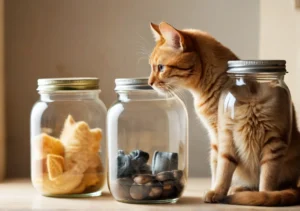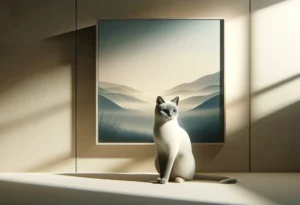Cats seem to have a strange fascination with their own reflections in mirrors. Have you ever wondered why this is the case? Let’s explore the reasons behind why cats are so obsessed with mirrors.
Evolutionary Instincts
Cats’ fascination with mirrors can be traced back to their evolutionary instincts. In the wild, cats rely on their keen sense of awareness to survive and thrive. Mirrors challenge their senses, prompting a natural curiosity to investigate the unfamiliar reflection staring back at them.
When a cat sees its reflection, it may interpret it as another cat invading its territory. This triggers a defensive response rooted in the instinct to protect its resources. This behavior is a survival mechanism that helps cats assess potential threats and maintain their safety in an ever-changing environment.
As solitary hunters, cats are wired to be alert and cautious, constantly monitoring their surroundings for any signs of danger. Mirrors present a novel stimulus that captures their attention, triggering a series of behaviors that stem from their innate need to stay vigilant and aware of their surroundings.
One unique angle to consider is that mirrors can also serve as a form of mental stimulation for indoor cats. By interacting with their reflections, cats engage their minds in a playful and challenging activity, which can help prevent boredom and promote mental agility. Thus, their fascination with mirrors can also be viewed as a way for them to exercise their cognitive abilities in a confined environment.
Social Behavior
Cats are not just solitary creatures—they also possess social behavior instincts that influence their interactions, even with their own reflections. When a cat sees itself in a mirror, it may interpret the image as another feline, triggering social behaviors such as playfulness, aggression, or even bonding.
For some cats, seeing their reflection can spark a desire for social interaction, leading them to engage with the mirror image as if it were a real companion. This behavior reflects their innate need for companionship and social stimulation, even if it comes in the form of a reflective surface.
Additionally, mirrors can serve as a tool for cats to practice their social skills, such as observing body language and facial expressions. By interacting with their reflections, cats may be honing their ability to communicate and understand subtle cues, preparing them for future social encounters with other animals or humans.
By embracing their fascination with mirrors, cat owners can provide their feline friends with mental stimulation and social engagement, enriching their lives and strengthening the bond between human and cat. So next time you catch your cat staring intently at its reflection, remember that it’s all part of their natural instincts and behaviors at play.
Territorial Marking
When cats see their reflections in mirrors, they may perceive them as intruders in their territory. Cats are naturally territorial animals, and they may view their reflection as another cat invading their space. This can trigger their instinct to protect their territory, leading to a fascination with the mirror and repeated attempts to investigate or confront their reflection.
Playful Interaction
Mirrors can provide cats with a source of entertainment and mental stimulation. Cats are curious creatures, and seeing their own reflections can spark their playful instincts. They may swat at the mirror, pounce on their reflection, or engage in other behaviors that mimic play. This interaction with their own image can be both amusing and engaging for cats, prompting them to return to the mirror for more fun.
Additional Insight:
– Cats may also be drawn to mirrors due to their reflective surface, which can make the environment appear larger and more interesting to them. This can contribute to their obsession with mirrors as they explore the new “territory” they see in the reflection.
Visual Stimulation
Uncover how the visual stimuli provided by mirrors can captivate cats’ attention and keep them engaged for extended periods. Mirrors reflect light and movement, creating an ever-changing visual display that entices our feline friends. The sight of another cat-like creature in the mirror triggers their natural hunting instincts, leading to curious behavior and a desire to interact with the “intruder.” The interactive nature of mirrors can provide endless entertainment for cats, offering a source of visual stimulation that keeps them captivated for hours on end.
Lack of Self-Awareness
Discuss the theory that cats may not recognize themselves in mirrors, leading to confusion and intrigue about the “other” cat in the reflection. While humans may understand that the image in the mirror is a reflection of themselves, cats may lack this level of self-awareness. This lack of understanding can result in cats viewing the mirror image as a separate entity, sparking curiosity and fascination. The mystery of the “other” cat in the reflection may drive cats to investigate further, trying to interact with this new and intriguing companion that seems to mimic their every move.
Additional unique insight: Cats’ obsession with mirrors could also stem from their innate curiosity and need for mental stimulation. The mystery and unpredictability of the mirror’s reflections may pique their interest, encouraging them to engage with this captivating and ever-changing visual experience. This constant source of mental stimulation can provide enrichment for cats, satisfying their curiosity and keeping them entertained in a safe and engaging manner.
Mirror Environments
Mirrors strategically placed around a cat’s environment can pique their curiosity and provide mental stimulation. Cats naturally love to explore new surroundings, and a mirror offers them a never-ending opportunity to investigate their reflection. Placing mirrors near their favorite spots like window sills or beds can keep them engaged and entertained. Additionally, mixing up the locations of mirrors from time to time can prevent them from losing interest. Cats may also use mirrors for social interaction, thinking they see another cat, making it an exciting addition to their environment.
Mirror Training
Introducing mirrors in cat training sessions can enhance mental agility and encourage positive behaviors. Incorporating mirrors into clicker training can help cats associate certain actions with rewards, promoting learning and obedience. Mirrors offer a unique visual feedback loop for cats, allowing them to see the results of their actions in real-time. Using mirrors in enrichment activities like puzzle games can also boost their problem-solving skills. Monitoring their reactions in front of mirrors during training can provide valuable insights into their behavior and emotions, helping trainers tailor their methods for better results.
Benefits of Mirror Training:
- Enhances cognitive abilities: Mirrors can challenge cats’ brains and stimulate their problem-solving skills.
- Promotes positive behaviors: By associating actions with rewards in front of mirrors, cats learn to repeat desirable behaviors.
- Provides visual feedback: Cats can see the consequences of their actions, aiding in their learning process.
- Encourages mental engagement: Interacting with mirrors keeps cats mentally stimulated and prevents boredom.
- Helps trainers understand behavior: Observing how cats react in front of mirrors can offer valuable cues for training adjustments.
Fun Facts About Cats and Mirrors
Did you know that cats can recognize themselves in a mirror? Yup, they are one of the few animals with this ability. When they see themselves, they might think it’s another cat invading their territory, hence the staring and pouncing.
Another fun fact is that some cats seem to enjoy watching themselves in the mirror because it mimics the act of looking out a window. It provides them with mental stimulation and entertainment.
And did you know that some cats might view their reflection as a potential mate? That’s right, they might show signs of affection, such as rubbing against the mirror or pawing at it, thinking they found a new furry friend.
Cat-Proofing Your Mirrors
If your cat’s mirror obsession is causing trouble, there are a few tricks you can try. First off, consider covering the mirror when you’re not using it to prevent your cat from constantly engaging with their reflection.
Placing scratch posts or toys near the mirror can divert their attention and keep them entertained. You can also use double-sided tape on the mirror’s edges to discourage pawing.
And here’s a unique tip – try placing a small, secure shelf near the mirror. Cats love to climb and explore new heights, so they might be more interested in climbing the shelf than staring at themselves in the mirror.
Remember, a cat’s fascination with mirrors is natural, but it’s essential to monitor their behavior to ensure their safety and well-being.
Alex, a passionate animal lover, has experience in training and understanding animal behavior. As a proud pet parent to two dogs and three cats, he founded AnimalReport.net to share insights from animal experts and expand his knowledge of the animal kingdom.




